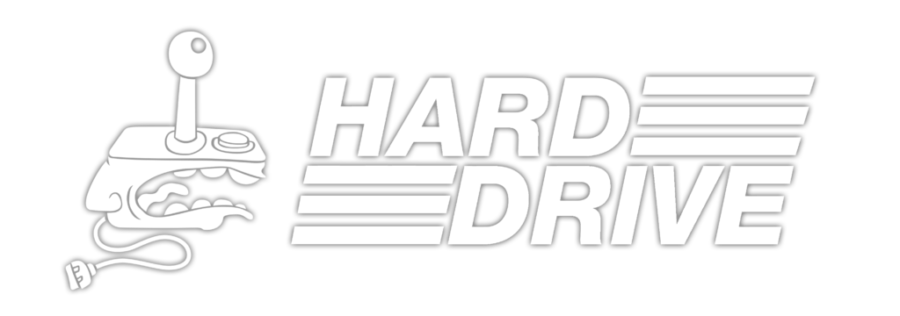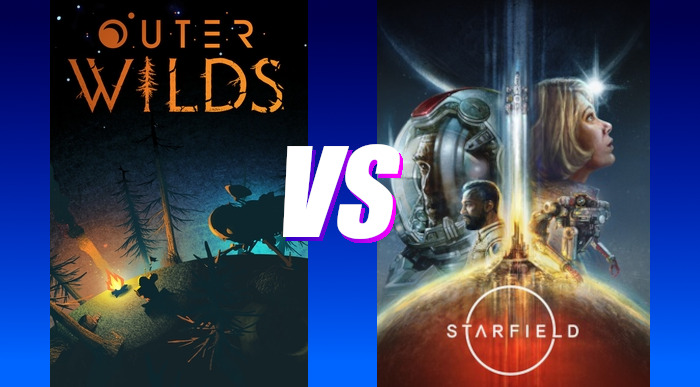In 2023, I played two space games – Starfield and Outer Wilds. In theory both games are, at their cores, space exploration games, but in actuality they couldn’t be more different. I walked away from Starfield feeling disappointed, but left the Outer Wilds hungry for more. What is it that made these two games have such dramatically different effects on me? Was I betrayed by Todd Howard? Was my lukewarm reaction to Starfield just another example of open-world fatigue, or was there a deeper reason?
Sixteen Times the Detail
As a big fan of both Fallout and The Elder Scrolls, I was seriously looking forward to Starfield. I loved everything I saw in the trailers. The gunplay looked satisfying, and greatly improved from Fallout 4. Dialogue options were finally back to being properly displayed instead of just vague notions of what your character might say. It seemed like Todd Howard had finally done it, and made the space game that he, and I, had been dreaming of. Sixteen times the detail, now on current gen hardware and in space.
I purchased the premium edition for the early access, and because I was confident I would want to play the accompanying DLC anyway. When I finally got my hands on the game I eagerly hopped right in, created my character, and was off to explore the galaxy. After how disappointed I was by that one Gollum game I was prepared for a masterpiece.
Except that isn’t what happened. Starfield has an agonizingly slow opening mission, and the pacing only barely improves from there. Nearly every mission I played felt like the same thing with a different coat of paint. An NPC tells you they need help retrieving something, or their friend is in trouble, or they’ve found a lead on a new artifact. You follow a quest marker to an unremarkable planet, discover a group of raiders, shoot them until they die, talk to a new NPC or grab a quest item, and return to the quest giver. It felt like every single quest from every single faction played out this way, with very few exceptions.
The worst part, though, is the loading screens. In that quest you would likely encounter sixteen loading screens, at least. You walk into an interior to talk to the quest giver and see a loading screen. Another loading screen to leave that building. Another two because you accidentally hit quick-load instead of quick-save. Traveling to another planet in your ship involves four: two for getting into and out of your ship, one for flying to another system, one for landing on a planet, and two unbelievably long unskippable animations for sitting down and standing up from the captain’s chair. Two more for entering and leaving the interior of an enemy camp, and then repeating all of that in reverse to return to the original quest giver, all for a quest that could have been an email.
I had been promised that current-gen consoles would make loading screens a relic of the past, but apparently that was a lie too.
The loading screens are exhausting. Gameplay is constantly interrupted by them, and would be even worse if you had a slower SSD. Many would say that fast travel is the solution to this problem. I disagree with that assessment – fast travel, while occasionally a helpful time saver, should not need to be so heavily incentivized in an exploration game.
Gamers are notorious for optimizing the fun out of everything. When given a chance to be more efficient, most will take that option. You never feel like you’re exploring in Starfield, because you never have to. If actually “manually” traveling everywhere is filled with loading screens anyway, why bother?
In the end, I never beat Starfield. I played for about forty hours before putting it down, and I never felt the need to go back to it. Just the thought of it was tiring, as it felt like work to play. I wasn’t enjoying my time with it, so I set my eyes on another space game.
Puzzles, Exploration, and Physical Comedy
I hadn’t heard much about Outer Wilds before deciding to purchase it. I had seen some positive reviews from when it released and some YouTube videos recommending it, but it was only barely on my radar. Because of this I had no idea what to expect going into it, which worked heavily in the game’s favor.
Outer Wilds is equal parts puzzles, exploration, and physical comedy. In a single loop you can discover a brand new location you had missed before, spend ten minutes scratching your head at what should be an easy puzzle, and fly face-first into a tree so hard that every bone in your body instantly shatters.
You can’t help but laugh at yourself every time you discover an obvious solution to a puzzle or destroy your ship when you make an autopilot error. Outer Wilds makes failure fun by making it a necessary part of the experience that allows you to laugh at yourself instead of being a frustrating setback.
Outer Wilds is a much smaller game than Starfield is. Every single element feels deliberately placed. Everything present in the game feels necessary, and there isn’t an ounce of fat. The game’s six planets are beautifully handcrafted, and each one is unique and fun to explore.
Because that’s what you do in Outer Wilds: You explore, just like you would expect from a space exploration game. The player is given very little direction at the start of the game. A few destinations are suggested, but you don’t have to go to them right away if you don’t want to.
You could even do what I did and die several times before even starting the time loop, resulting in a game over.
The story is primarily presented through text on walls, allowing the player to slowly uncover the mystery of what happened to an ancient race called the Nomai, what they were trying to accomplish, and why they were unable to succeed. All of this gets recorded in your ship log, but you have to decide which leads are worth exploring and which aren’t.
A solar system that initially feels somewhat small becomes the stage of something much bigger than the player, and every new discovery feels like a revelation. Many times throughout the game I was in awe at just how smart I felt for discovering what may or may not have been an intended solution to a puzzle.
I was also in awe at how this game had me convinced that flying into the sun dozens of times in a row until I landed on the low-orbit space station was the correct solution.
The ending of Outer Wilds is one of my favorites of any game I’ve played. I can’t go into further detail on it without seriously ruining the game for anyone that hasn’t played it, but it succeeds in tying together every piece of information you acquire throughout the game, resulting in a satisfying conclusion to an already fantastic experience. It feels like every clue you get throughout the game actually mattered in bringing you to the end.
So basically, the opposite of the Lost TV series ending.
Starfield is a mile wide, but an inch deep
When I started playing Starfield I expected Skyrim in space, but that’s not what I got. Skyrim is a game where, no matter where you are, you always know that a secret is hidden just around the corner, and fast traveling rarely feels worth it; the main draw of the game is exploration, and using fast travel is robbing yourself of that experience.
Not every game needs to offer such a complete sense of exploration, but players expected this one to. The game was marketed as the space game that Todd Howard always wanted to make. As a game that would make players feel the same way they felt the first time they played Skyrim: the feeling of truly exploring the unexplored, of going off the beaten path and discovering something new at every turn. Of being launched into the sky by physics jank and landing somewhere you didn’t even know existed.
Starfield does not provide that same feeling. Every planet feels interchangeable. I never once found a worthwhile reason to do anything except mindlessly follow the quest marker, and so much of the game feels half-baked.
So many mechanics in Starfield are meaningless at best, and actively harm the game at worst. You’re often told you do not have a powerful enough warp drive to reach a far-away system, but you can just warp to a slightly closer one and warp again. The only penalty to this is that you have to watch another loading screen, when you could have just fast traveled and saved yourself ten seconds.
Starfield decided that a good exploration game needs to be big. More planets. More places to go. It’s a mile wide, but an inch deep. The entirety of the game just feels like a facade. An unfathomably large, empty environment to distract from the fact that none of it has any purpose. It’s a theme park without any working rides. Why would you ever explore 90% of the planets when the only things you’ll find are procedurally generated terrain and copy-pasted enemy camps?
Outer Wilds, on the other hand, feels real. It feels like more time and care was put into every nook and cranny of every planet in that game than any planet in Starfield. It does what Skyrim did back in 2011: it makes the player feel lost, then allows them to naturally stumble across something they’d never seen before. It makes the player want to continue exploring. It rewards the player’s time, giving them back more than they put in.
Starfield may not provide the sense of adventure and exploration that a “Skyrim in space” should, but Outer Wilds does.



